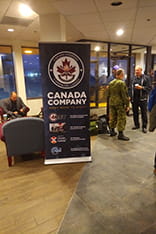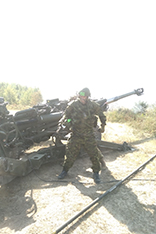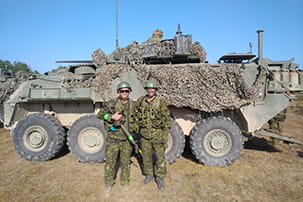Exercise Collaborative Spirit 2017

Recently, I was fortunate to participate in the 2017 edition of Exercise COLLABORATIVE SPIRIT, courtesy of Canada Company. This hands-on military experience took place at 4th Canadian Division Support Base Petawawa which is near Pembroke, Ontario north east of Ottawa.
Held annually, Exercise COLLABORATIVE SPIRIT provides senior members of the public service and Canada’s business community an opportunity to gain a deeper appreciation of the expertise of Canadian soldiers through a uniquely immersive experience. Hosted by Brigadier General Steve Cadden and Chief Warrant, Stu Hartnell, the main purpose of the Exercise is to connect Canadians with the Canadian Army’s greatest asset: our soldiers.
Importantly, through the association with Canada Company, there is a charitable element to the day. Led by its Chairman Blake Goldring, better known to many of you as the chairman and CEO of AGF Management Limited as well as an Honorary Colonel of the Canadian Army, Canada Company provides scholarships and other assistance to the families of fallen members, helps transitioning members of the Canadian Armed Forces find jobs in corporate Canada and also helps military spouses find employment. Appropriately, given their mandate, Canada Company’s slogan is “Many Ways to Serve.” During our visit, Mr. Goldring presented a cheque for $15,000 to the Petawawa Military Family Resource Centre which provides support for families of deployed soldiers. Osisko Mining matched this amount bringing the total donation to $30,000. An additional $5,000 is being directed to the METSpouse Program managed by Canada Company.
Our day on the base ran the gamut from the expected (sort of) to the unexpected. I expected we would have an opportunity to learn about some of the weapons used by our armed forces as well as tactics and drills. What I didn’t anticipate was an opportunity to gain some important insights into how the military operates as a workplace.

The Royal Canadian Dragoons and The Royal Canadian Horse Artillery ran the weapons familiarization range for Exercise COLLABORATIVE SPIRIT in the training area of Camp Petawawa. The Dragoons had a number of weapons laid out to teach us how to properly handle and fire them. Weapons ranged from small - 9mm pistol - to very, very large - the M777 howitzer. Between the stand firing and the heavy artillery going off, it was pretty loud on the firing pad. As it turns out, this was way more hands on than anticipated … here I am firing the M777 ….
During the exercise we also had an opportunity to run a drill with 2 Canadian Mechanized Brigade Group. Supported by artillery and infantry, approximately 20 LAVs (comprising a company) set-up and ran a well-coordinated drill that involved securing a variety of hostile positions on challenging terrain (just ask the guys sitting in the back of the LAV how challenging …)
In between the above and following another drill, BGen Cadden, the officer in charge of the exercise, debriefed the ~200 people participating in the day’s operations. Interestingly, many of his comments focused on the importance of workplace culture which made me better appreciate that the military is a workplace just like any other. BGen Cadden highlighted several key cultural values that are critical to the success of our armed forces including respect, professionalism and the importance of continuous learning. We strive to honour those same values in our workplace.

BGen Cadden and I had a chance to discuss his comments further over dinner. While the military still runs on a command and control philosophy, there is no doubt that a 3rd C, communication, is integral to their success. While debriefing us in an AAR (after action review), BGen Cadden was quick to lay out the ground rules. The AAR is centred on four questions:
- What was expected to happen?
- What actually occurred?
- What went well and why?
- What can be improved and how?
An effective AAR features an open and honest professional discussion, participation by everyone on the team, a focus on results, identification of ways to sustain what went well and development of recommendations on ways to overcome obstacles. In short, the military strives for continuous improvement but doesn’t make it personal. Along with developing a greater appreciation for the men and women serving in our armed forces, I think the structure of the AAR was one of the most important things I learned through the day and something I will be bringing back to my workplace.
As an aside, there is also a personal angle to this story for me. My grandfather trained at Petawawa as a tank commander during WWII. It was interesting to think that I likely traversed some of the same ground as he did roughly 75 years ago.
Follow this link to learn more about Exercise COLLABORATIVE SPIRIT: Exercise Collaborative Spirit
Follow this link to learn more about Canada Company: www.canadacompany.ca




